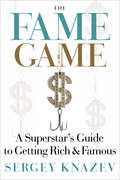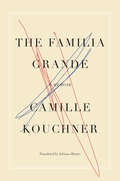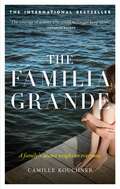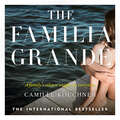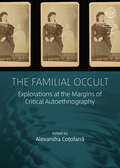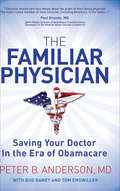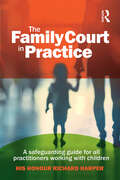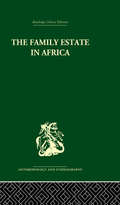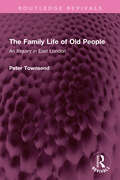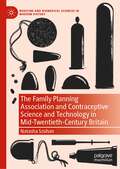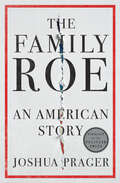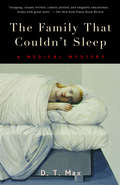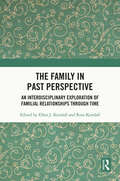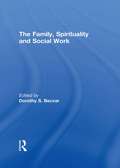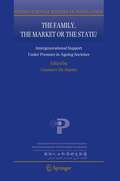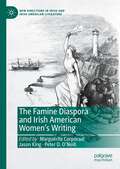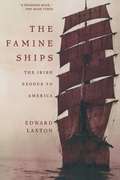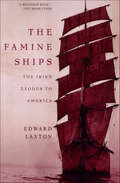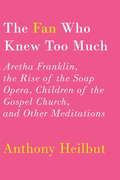- Table View
- List View
The Fame Game: A Superstar's Guide to Getting Rich and Famous
by Sergey KnazevHollywood is where even the wildest dreams can come true no matter who you are, where you come from, or even what you know. In Hollywood, everyone is a potential star and newsstands overflow with gossip about the latest celebrity mishaps, conflicts, and achievements so that millions can live vicariously through the lives of their favorite movie stars.
The Familia Grande: A Memoir
by Camille KouchnerA stunning story about finding the courage to speak out against injustice, even when committed by those closest to us.Camille Kouchner&’s childhood was marked by sun-drenched summers in the south of France, where a vibrant cast of family and friends would gather at their Sanary-sur-Mer house. This familia grande, which included much of the country&’s elite, spent memorable days and nights laughing, debating, drinking, and dancing. But a long-held secret poisoned Camille&’s memories. In February 2017, Camille returned to Sanary at forty-one to bury her mother, who died with none of her five children present. Her passing would stir up old emotions, ultimately leading Camille to publicly confront the truth. The Familia Grande poignantly explores the dynamics of abuse, and the questions of guilt and shame surrounding it. Published in France in 2021, the book sparked an important conversation about incest, and the attitudes and laws that have so often allowed influential men to evade consequences for their crimes.
The Familia Grande: A family's silence weighs on everyone
by Camille KouchnerTHE LITERARY SENSATION THAT STORMED THE WORLD, THE PHENOMENAL FRENCH BESTSELLER HAS SOLD 350,000 COPIESTHE BOOK THAT SPARKED THE VIRAL #METOOINCEST MOVEMENTA family's secret weighs on everyone...THE FAMILIA GRANDE is a tender, groundbreaking and lacerating memoir written by a sister who could no longer remain silent...Set in amongst the French intellectual elite in Paris and their lavender scented estates in Provence, it tells a story of a corrosive secret that sits in a family for decades and ultimately razes it and the political, literary elite that enabled its silence, to the ground.Already an international bestseller, it has touched a nerve across the globe and has brought about a powerful reckoning of incest, and its far-reaching trauma.The Familia Grande is a book of a generation.'The courage of a sister who could no longer keep quiet.' - EMMANUEL MACRON 'Camille's battle to liberate herself from a painful family secret has touched a nerve across France' - THE NEW YORK TIMES
The Familia Grande: A family's silence weighs on everyone
by Camille KouchnerTHE LITERARY SENSATION THAT STORMED THE WORLD,THE PHENOMENAL FRENCH BESTSELLER HAS SOLD 350,000 COPIESTHE BOOK THAT SPARKED THE VIRAL #METOOINCEST MOVEMENTA family's secret weighs on everyone...THE FAMILIA GRANDE is a tender, groundbreaking and lacerating memoir written by a sister who could no longer remain silent...Set in amongst the French intellectual elite in Paris and their lavender scented estates in Provence, it tells a story of a corrosive secret that sits in a family for decades and ultimately razes it and the political, literary elite that enabled its silence, to the ground.Already an international bestseller, it has touched a nerve across the globe and has brought about a powerful reckoning of incest, and its far-reaching trauma.The Familia Grande is a book of a generation.'The courage of a sister who could no longer keep quiet.' - EMMANUEL MACRON'Camille's battle to liberate herself from a painful family secret has touched a nerve across France' - THE NEW YORK TIMES(p) 2022 Octopus Publishing Group
The Familial Occult: Explorations at the Margins of Critical Autoethnography (EASA Series #47)
by Alexandra CoţofanăThe Familial Occult addresses the presence of occult experiences in some scholars' families and how that has affected their epistemological and ontological worlds, as well as their identities as scholars. Those with backgrounds in the familial occult often experience a series of conflicting relationships and different ways of interacting with binaries such as the subjective and objective, a powerful conceptual couple still governing academic thinking. While much has been written on encountering the occult in fieldwork or becoming an apprentice in an occult practice, little yet has been published in the academic literature about growing up with the occult.
The Familiar Physician: Saving Your Doctor In the Era of Obamacare
by Bud Ramey Tom Emswiller Peter B. AndersonPowerful forces of change are at the core of Obamacare—and they could either strengthen or destroy our family doctors. It’s a perfect storm that threatens our hope for more effective and personalized medical care and it holds the potential to drive our trusted Familiar Physicians toward extinction. In the midst of the storm is a new and promising approach within Obamacare called the medical home. Learn what you can do to help assure that the Familiar Physician, the basis for a strong physician-patient relationship, survives the approaching storm. On a national level, there are heroes here—doctors who redirected their lives to make this change happen. Not just for a few months, but for a decade-long crusade. This is the story of Dr. Peter Anderson, a pioneer in team care medicine and a passionate champion for primary care. The Familiar Physician is about the extraordinary vision of IBM’s Dr. Martin Sepúlveda and the powerful crusade of advocacy carried out by IBM’s Dr. Paul Grundy. Their ten-year quest to create solutions for this crisis in primary care has powerful outcomes. Hope is on the horizon, but the struggle is far from over.
The Family Court in Practice: A safeguarding guide for all practitioners working with children
by Richard HarperWritten by an experienced former senior judge of the family court, this practical guide provides all students and practitioners working with children with a clear understanding of safeguarding good practice and the principles and proceedings of the family court.Where there is serious risk of harm, it examines how all involved in the community or family court proceedings can place the child at the centre of their practical decision-making. Incorporating the most up-to-date legislation, and emphasising the importance of multi-agency working, the book enables practitioners, and all stakeholders, to better understand the workings of the family court and to recognise and implement appropriate actions. Fictional case studies with critical questions are included to encourage deep reflection and ways to apply new-found knowledge to practice. The book demystifies the family court to provide an accessible guide for students and both experienced and newly qualified practitioners.Chapters delve into the structure of the family court, preparing reports and statements, public and private court proceedings, giving evidence, and urgent interventions. The author's professional experience and expertise ensures readers are fully equipped with a unique and practical understanding for safeguarding the welfare of children within the family court system.
The Family Estate in Africa: Studies in the Role of Property in Family Structure and Lineage Continuity
by Robert F Gray Ρ Η GulliverToo often accounts of African family life have tended to describe the family in purely static terms. The contributors to this book emphasize the developmental or time dimension of the family, analysing it as a process. In the seven different societies described in East Africa, the Congo and the Transvaal the changing nature of the distribution of rights in the family property and resources is directly linked with the growth and change of the family itself. First published in 1964.
The Family Fund: An Initiative in Social Policy (Routledge Revivals)
by Jonathan BradshawIn The Family Fund, first published in 1980, Bradshaw discusses the introduction of The Family Fund- a grant given to families in response of the discovery of the damages caused by the Thalidomide drug. He examines all aspects of the Fund including its origins, aims, publicity and its future. This text is ideal for students of sociology.
The Family Guide to Getting Over OCD: Reclaim Your Life and Help Your Loved One
by Jonathan S. AbramowitzWhen a loved one has OCD, it's a constant struggle. It hurts to see your spouse so anxious or your teen spending so much time alone. You've tried logic, reassurance, even accommodating endless rituals--but, too often, these well-meaning attempts actually make OCD worse. Psychologist Jonathan Abramowitz has worked with countless families affected by OCD, and he understands the strain. He also knows you can turn things around. Grounded in state-of-the-art treatment research, this compassionate guide helps you change your own behavior to support your loved one's recovery. By gently but firmly encouraging the person you care about to face their fears, you can stop being controlled by the disorder, disentangle yourself from unhealthy patterns, and see your whole family grow more confident and hopeful. Vivid stories, dos and don'ts, and practical tools (which you can download and print for repeated use) help you follow the step-by-step strategies in this life-changing book.
The Family In Rural Society
by Raymond T Coward William M Smith Peter L Heller Louis A PlochSocial and political attention often is focused on urban issues, neglecting the still-rural character of much of the United States. This volume of original papers provides a clear picture of present-day rural society, with special emphasis on the changing role and structure of the family. It describes demographic trends, discusses the family aspects of the new wave of inmigrants to small towns and rural communities, reviews the diversity of patterns and forms adopted by rural families, considers the plight of the rural aged, and explores the dynamics of intrafamily personal relationships. The book ends with speculations on future prospects and challenges facing rural families.
The Family Life of Old People: An Inquiry in East London (Routledge Revivals)
by Peter TownsendFirst published in 1957, The Family Life of Old People opens with the question: Are old people isolated from their families? Thereafter, the author describes the results of intensive interviews with people of pensionable age in Bethnal Green in East London. Part one shows that most people are members of closely-knit extended families of three generations, often living in separate households in adjoining streets. The life of these families is of absorbing interest and the social structure of the home, the system of family care and the domestic, economic and social relationships between husbands and their wives, and between old people and their children and brothers and sisters, are carefully analysed. Part two discusses the social problems of old age against this background. This book will be of interest to students of sociology and gerontology.
The Family Life of Sick Children: A Study of Families Coping with Chronic Childhood Disease (Routledge Library Editions: Health, Disease and Society #8)
by Lindy BurtonOriginally published in 1975, this book traces the problems which arise for families coping with a chronic childhood disease – cystic fibrosis. The discussion of these problems is important for the families of other seriously ill or disabled children, all of whom are faced with similar implications of their situation. The book looks at the stressful situations which face them: mastering the child’s treatment technique, assisting them to come to terms with their disease. It deals with the practical problems which arise for the parents and siblings of a sick child and explores the profound repercussions of the loss of a child on the entire family, considering the ways in which many of these families managed to transcend their problems.
The Family Planning Association and Contraceptive Science and Technology in Mid-Twentieth-Century Britain (Medicine and Biomedical Sciences in Modern History)
by Natasha SzuhanThis book offers the first in-depth investigation into the relationship between the National Birth Control Association, later the Family Planning Association, and contraceptive science and technology in the pre-Pill era. It explores the Association’s role in designing and supporting scientific research, employment of scientists, engagement with manufacturers and pharmaceutical companies, and use of its facilities, patients, staff, medical, scientific, and political networks to standardise and guarantee contraceptive technology it prescribed and produced. By taking a micro-history approach to the archives of the Association, this book highlights the importance of this organisation to the history of science, technology, and medicine in twentieth-century Britain. It examines the Association’s participation within Western family planning networks, working particularly closely with its American counterparts to develop chemical and biological means of testing contraception for efficacy, quality, and safety.
The Family Roe: An American Story
by Joshua PragerFinalist for the 2022 Pulitzer Prize for General Nonfiction Finalist for the J. Anthony Lukas Book Prize Finalist for the National Book Critics Circle Award for Nonfiction One of NPR's Best Books of 2021 A New York Times Notable Book of 2021 One of TIME's 100 Must-Read Books of 2021 "The scope is sweeping, the writing is beautiful. It’s an epic story worthy of the impact this one case has had on the American psyche." —Michel Martin, NPR "Stupendous…. If you want to understand Roe more deeply before the coming decision, read it." —Peggy Noonan, Wall Street Journal A masterpiece of reporting on the Supreme Court’s most divisive case, Roe v. Wade, and the unknown lives at its heart. Despite her famous pseudonym, “Jane Roe,” no one knows the truth about Norma McCorvey (1947–2017), whose unwanted pregnancy in 1969 opened a great fracture in American life. Journalist Joshua Prager spent hundreds of hours with Norma, discovered her personal papers—a previously unseen trove—and witnessed her final moments. The Family Roe presents her life in full. Propelled by the crosscurrents of sex and religion, gender and class, it is a life that tells the story of abortion in America. Prager begins that story on the banks of Louisiana’s Atchafalaya River where Norma was born, and where unplanned pregnancies upended generations of her forebears. A pregnancy then upended Norma’s life too, and the Dallas waitress became Jane Roe. Drawing on a decade of research, Prager reveals the woman behind the pseudonym, writing in novelistic detail of her unknown life from her time as a sex worker in Dallas, to her private thoughts on family and abortion, to her dealings with feminist and Christian leaders, to the three daughters she placed for adoption. Prager found those women, including the youngest—Baby Roe—now fifty years old. She shares her story in The Family Roe for the first time, from her tortured interactions with her birth mother, to her emotional first meeting with her sisters, to the burden that was uniquely hers from conception. The Family Roe abounds in such revelations—not only about Norma and her children but about the broader “family” connected to the case. Prager tells the stories of activists and bystanders alike whose lives intertwined with Roe. In particular, he introduces three figures as important as they are unknown: feminist lawyer Linda Coffee, who filed the original Texas lawsuit yet now lives in obscurity; Curtis Boyd, a former fundamentalist Christian, today a leading provider of third-trimester abortions; and Mildred Jefferson, the first black female Harvard Medical School graduate, who became a pro-life leader with great secrets. An epic work spanning fifty years of American history, The Family Roe will change the way you think about our enduring American divide: the right to choose or the right to life.
The Family That Couldn't Sleep: A Medical Mystery
by D. T. MaxFor two hundred years a noble Venetian family has suffered from an inherited disease that strikes their members in middle age, stealing their sleep, eating holes in their brains, and ending their lives in a matter of months. In Papua New Guinea, a primitive tribe is nearly obliterated by a sickness whose chief symptom is uncontrollable laughter. Across Europe, millions of sheep rub their fleeces raw before collapsing. In England, cows attack their owners in the milking parlors, while in the American West, thousands of deer starve to death in fields full of grass. What these strange conditions–including fatal familial insomnia, kuru, scrapie, and mad cow disease–share is their cause: prions. Prions are ordinary proteins that sometimes go wrong, resulting in neurological illnesses that are always fatal. Even more mysterious and frightening, prions are almost impossible to destroy because they are not alive and have no DNA–and the diseases they bring are now spreading around the world. In The Family That Couldn’t Sleep, essayist and journalist D. T. Max tells the spellbinding story of the prion’s hidden past and deadly future. Through exclusive interviews and original archival research, Max explains this story’s connection to human greed and ambition–from the Prussian chemist Justus von Liebig, who made cattle meatier by feeding them the flesh of other cows, to New Guinean natives whose custom of eating the brains of the dead nearly wiped them out. The biologists who have investigated these afflictions are just as extraordinary–for example, Daniel Carleton Gajdusek, a self-described “pedagogic pedophiliac pediatrician” who cracked kuru and won the Nobel Prize, and another Nobel winner, Stanley Prusiner, a driven, feared self-promoter who identified the key protein that revolutionized prion study. With remarkable precision, grace, and sympathy, Max–who himself suffers from an inherited neurological illness–explores maladies that have tormented humanity for centuries and gives reason to hope that someday cures will be found. And he eloquently demonstrates that in our relationship to nature and these ailments, we have been our own worst enemy.
The Family in Past Perspective: An Interdisciplinary Exploration of Familial Relationships Through Time
by Ellen J. Kendall Ross KendallThis volume takes a more comprehensive view of past familial dynamics than has been previously attempted. By applying interdisciplinary perspectives to periods ranging from the Prehistoric to the Modern, it informs a wider understanding of the term family, and the implications of family dynamics for children and their social networks in the past. Contributors drawn from across the humanities and social sciences present research addressing three primary themes: modes of kinship and familial structure, the convergence and divergence between the idealised image and realities of family life, and the provision of care within families. These themes are interconnected, as the idea and image of family shapes familial structure, which in turn defines the type of care and protection that families provide to their members. The papers in this volume provide new research to challenge assumptions and provoke new ways of thinking about past families as functionally adaptive, socially connected, and ideologically powerful units of society, just as they are in the present. A broad focus on the networks created by familial units also allows the experiences of historically underrepresented women and children to be highlighted in a way that underlines their interconnectedness with all members of past societies. The Family in Past Perspective builds a much-needed bridge across disciplinary boundaries. The wide scope of the book hmakes important contributions, and informs fields ranging from bioarchaeology to women's history and childhood studies.
The Family in Roman Egypt
by Sabine R. HuebnerThis study captures the dynamics of the everyday family life of the common people in Roman Egypt, a social strata that constituted the vast majority of any pre-modern society but rarely figures in ancient sources or in modern scholarship. The documentary papyri and, above all, the private letters and the census returns provide us with a wealth of information on these people not available for any other region of the ancient Mediterranean. The book discusses such things as family composition and household size and the differences between urban and rural families, exploring what can be ascribed to cultural patterns, economic considerations and/or individual preferences by setting the family in Roman Egypt into context with other pre-modern societies where families adopted such strategies to deal with similar exigencies of their daily lives.
The Family of Woman: Lesbian Mothers, Their Children, and the Undoing of Gender
by Maureen SullivanDrawing upon interviews with gay families, Sullivan contends that gay families have more equitable social relations and move forward in equalizing gender roles.
The Family, Spirituality, and Social Work
by Dorothy BecvarOne of the few books on this topic, The Family, Spirituality, and Social Work offers mental health professionals new information and research for creating more positive, effective, and satisfying sessions. You will learn how integrating spirituality and therapy can create open and trusting environments where clients feel accepted, respected, and spiritually affirmed.Studies show that religion is not only a way for people to be closer to their god but is also a part of their identity that dictates what they do, how they think, and who they are. The Family, Spirituality, and Social Work will help you understand what religion means to your clients and discusses different methods of answering the questions, “What is religion?” and “How does religion affect our lives?” In addition, you will gain insight into: how a social constructionist perspective can create the most successful sessions for your patients cases studies of how therapists’personal biases, lack of adequate education, personal discomfort, and self-serving needs may contribute to problems and complications in therapy the importance of including spirituality in the education of social workers and other therapists in order to avoid problems and complications with clients the nine major components of spirituality, defined in psychological terms the guidance women may need in therapy to find themselves spiritually given male-centered biases and patriarchal values in many spiritual traditions the seven steps used to help women find their spirituality, including awakening and discovering, as well as a practice model that will help practitioners address women’s spirituality how and why the relational systems model (RSM) can promote wholeness and growth in family therapy groupsProviding you with information on how people perceive religion and spirituality, The Family, Spirituality, and Social Work also features studies of the therapeutic needs of those with different religious beliefs. With this solid knowledge and understanding of religion and spirituality and how it may affect clients, you will create a trusting environment that enhances your clients’experiences and makes you a more successful practitioner.
The Family, the Market or the State?
by Gustavo De SantisThis book touches upon a few of the major challenges that all modern societies will have to face in the near future: how to set up a resilient pay-as-you-go pension system; whether the current balance between expenses and revenues in social expenditure is viable in the future, and, if not, what changes need to be introduced; whether the relative well-being of the current and future cohorts of the old will be preserved, and how their standards of living compare to those experienced by the old in the recent past. At the micro level, the exchanges between generations are presented and discussed in detail: how they have evolved in the recent past in terms of time, money, co-residence and proximity, and what will likely happen next. The geographical scope is on the developed countries, plus South Korea. A rich documentation of tables and graphs supports the scientific analyses and the policy implications in each of the nine chapters of this book, where demography, sociology, and economics intersect fruitfully, both at the macro and at the micro level.
The Famine Diaspora and Irish American Women's Writing (New Directions in Irish and Irish American Literature)
by Jason King Marguérite Corporaal Peter D. O’NeillThe Famine Diaspora and Irish American Women’s Writing considers the works of eleven North American female authors who wrote for or descended from the Irish Famine generation: Anna Dorsey, Christine Faber, Elizabeth Gurley Flynn, Mother Jones, Kate Kennedy, Margaret Dixon McDougall, Mary Meaney, Alice Nolan, Fanny Parnell, Mary Anne Sadlier, and Elizabeth Hely Walshe. This collection examines the ways the writings of these women contributed significantly to the construction of Irish North-American identities, and played a crucial role in the dissemination of Famine memories transgenerationally as well as transnationally. The included annotated excerpts from these women writers’ works and the accompanying essays by prominent international scholars offer insights on the sociopolitical position of the Irish in North America, their connections with the homeland, women’s activities in transnational (often Catholic) publishing networks and women writers’ mediation of Ireland’s cultural heritage. Furthermore, the volume illustrates the generic variety of Irish American women’s writing of the Famine generation, which comprises political treatises, novels, short stories and poetry, and bears witness to these female authors’ profound engagement with political and social issues, such as the conditions of the poor and woman’s vote.
The Famine Ships: The Irish Exodus to America
by Edward LaxtonBetween 1846 and 1851, more than one million people--the potato famine emigrants--sailed from Ireland to America. Now, 150 years later, The Famine Ships tells of the courage and determination of those who crossed the Atlantic in leaky, overcrowded sailing ships and made new lives for themselves, among them the child Henry Ford and the twenty-six-year-old Patrick Kennedy, great-grandfather of John F. Kennedy. Edward Laxton conducted five years of research in Ireland and interviewed the emigrants' descents in the U.S. Portraits of people, ships, and towns, as well as facsimile passenger lists and tickets, are among the fascinating memorabilia in The Famine Ships.
The Famine Ships: The Irish Exodus to America
by Edward LaxtonA “fascinating” account of the experiences of the Irish emigrants who fled a catastrophic crop failure and built new lives across the Atlantic (Library Journal).Between 1846 and 1851, more than one million people—the potato famine emigrants—sailed from Ireland to America. The Famine Ships tells of the courage and determination of those who crossed the Atlantic in leaky, overcrowded sailing ships and made new lives for themselves, among them the child Henry Ford and the twenty-six-year-old Patrick Kennedy, great-grandfather of John F. Kennedy.Edward Laxton conducted five years of research in Ireland and interviewed the emigrants’ descendants in the United States. Portraits of people, ships, and towns, as well as facsimile passenger lists and tickets, are among the compelling memorabilia in The Famine Ships.“A fascinating compilation derived from family histories handed down through the generations; it describes both the horrible conditions aboard the ships and the emigrants’ boundless optimism concerning the freedom of America . . . finally draws attention to the people and the ships that defined a moment in Irish and American history.” —Library Journal“A splendid book, written in a fresh and accessible way.” —Irish TimesIncludes photos and illustrations
The Fan Who Knew Too Much
by Anthony HeilbutA dazzling exploration of American culture--from high pop to highbrow--by acclaimed music authority, cultural historian, and biographer Anthony Heilbut, author of the now classic The Gospel Sound ("Definitive" --Rolling Stone), Exiled in Paradise, and Thomas Mann ("Electric"--Harold Brodkey). In The Fan Who Knew Too Much, Heilbut writes about art and obsession, from country blues singers and male sopranos to European intellectuals and the originators of radio soap opera--figures transfixed and transformed who helped to change the American cultural landscape. Heilbut writes about Aretha Franklin, the longest-lasting female star of our time, who changed performing for women of all races. He writes about Aretha's evolution as a singer and performer (she came out of the tradition of Mahalia Jackson); before Aretha, there were only two blues-singing gospel women--Dinah Washington, who told it like it was, and Sister Rosetta Tharpe, who specialized, like Aretha, in ambivalence, erotic gospel, and holy blues. We see the influence of Aretha's father, C. L. Franklin, famous pastor of Detroit's New Bethel Baptist Church. Franklin's albums preached a theology of liberation and racial pride that sold millions and helped prepare the way for Martin Luther King Jr. Reverend Franklin was considered royalty and, Heilbut writes, it was inevitable that his daughter would become the Queen of Soul. In "The Children and Their Secret Closet," Heilbut writes about gays in the Pentecostal church, the black church's rock and shield for more than a hundred years, its true heroes, and among its most faithful members and vivid celebrants. And he explores, as well, the influential role of gays in the white Pentecostal church. In "Somebody Else's Paradise," Heilbut writes about the German exiles who fled Hitler--Einstein, Hannah Arendt, Marlene Dietrich, and others--and their long reach into the world of American science, art, politics, and literature. He contemplates the continued relevance of the émigré Joseph Roth, a Galician Jew, who died an impoverished alcoholic and is now considered the peer of Kafka and Thomas Mann. And in "Brave Tomorrows for Bachelor's Children," Heilbut explores the evolution of the soap opera. He writes about the form itself and how it catered to social outcasts and have-nots; the writers insisting its values were traditional, conservative; their critics seeing soap operas as the secret saboteurs of traditional marriage--the women as castrating wives; their husbands as emasculated men. Heilbut writes that soaps went beyond melodrama, deep into the perverse and the surreal, domesticating Freud and making sibling rivalry, transference, and Oedipal and Electra complexes the stuff of daily life. And he writes of the "daytime serial's unwed mother," Irna Phillips, a Chicago wannabe actress (a Margaret Hamilton of the shtetl) who created radio's most seminal soap operas--Today's Children, The Road of Life among them--and for television, As the World Turns, Guiding Light, etc., and who became known as the "queen of the soaps." Hers, Heilbut writes, was the proud perspective of someone who didn't fit anywhere, the stray no one loved. The Fan Who Knew Too Much is a revelatory look at some of our American icons and iconic institutions, high, low, and exalted.From the Hardcover edition.
